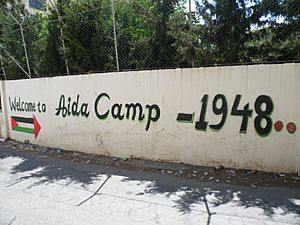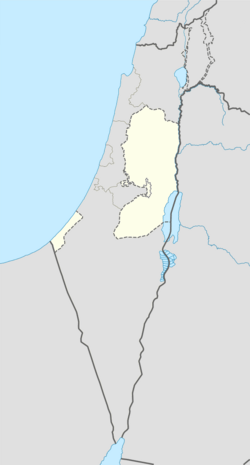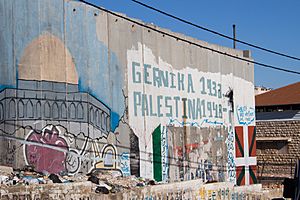Aida Camp facts for kids
Quick facts for kids
Aida
|
|
|---|---|
|
Refugee camp
|
|
| Arabic transcription(s) | |
| • Arabic | مخيم عايده |
| • Latin | 'Ayda (official) |

Mural at the entrance to Aida camp
|
|
| State | State of Palestine |
| Governorate | Bethlehem |
| Government | |
| • Type | Refugee camp (from 1950) |
| Area | |
| • Total | 71 dunams (0.071 km2 or 0.027 sq mi) |
| Population | |
| • Total | 2,824 |
| • Density | 39,770/km2 (103,000/sq mi) |

Aida (Arabic: مخيم عايده), also spelled Ayda, is a Palestinian refugee camp. It is located about 2 kilometers north of the historic center of Bethlehem. It is also 1 kilometer north of Beit Jala, in the central West Bank, State of Palestine.
A refugee camp is a place where people who have been forced to leave their homes find shelter. According to the UNRWA, which helps Palestinian refugees, about 5,498 refugees lived in Aida camp at the end of 2014. A later count in 2017 showed 2,824 residents.
Contents
History of Aida Camp
How Aida Camp Started
Aida camp was named after a well-known coffeehouse that was in the area in the early 1940s. The camp was set up in 1950. It was created for refugees who came from the Jerusalem and Hebron areas.
When it first started, Aida camp covered an area of 66 dunams (about 0.07 square kilometers). At that time, 1,125 refugees lived there in 94 tents.
Challenges During Conflict
The camp faced many difficulties during a period known as the Second Intifada. During this time, the camp's school was badly damaged. Also, 29 homes were destroyed due to military actions.
The military placed the camp and nearby areas under strict curfews. People were arrested, and walls between houses were sometimes broken down. This was done to allow soldiers to move through the camp without using the main roads.
One sad event involved a camp resident named Huda Hawaja. She was badly hurt when soldiers broke down her doors. She later died because there were delays in getting an ambulance due to the military presence. This event was shown on TV and caused a lot of public concern.
Important Visits and Events
Pope Benedict XVI visited the refugee camp in May 2009. This was part of his trip to Jordan, Israel, and the Palestinian territories. He said that the refugees lived in "precarious and difficult conditions." He also mentioned that it was "tragic to see walls still being erected."
In October 2015, a video was filmed by a resident of Aida camp. It showed a military vehicle making a loud announcement during a raid. The speaker warned residents that if they threw stones, they would be gassed until they died. The speaker also said they had arrested someone and would harm him if stones continued to be thrown. After this incident, the police suspended the officer involved. They also reviewed his continued service.
Aida Camp Today
Location and Surroundings
Aida camp is located next to Rachel's Tomb. It is separated from Jerusalem by a large wall, known as the Israeli West Bank barrier. It is also close to an Israeli settlement called Gilo.
Near the camp, there is a modern 4-star hotel, the Jacir Palace. At the entrance gate of the camp, there is a huge picture of a "key of return." This key is a symbol for the Palestinian right to return to their original homes. On the separation barrier, there is a large painting with the words "Gernika 1936 – Palestina 1948." This painting compares the bombing of a town in Spain to events in Palestine.
Life in the Camp
Aida camp has two schools for children. However, it does not have its own health clinics. The UNRWA does help by providing doctors and physical therapists to offer medical care inside the camp.
Access to clean water is often a problem for the people living in Aida. The sewage system is also not very good. The unemployment rate in Aida is quite high, at 43%. This means almost half of the people who want to work cannot find jobs.
Culture and Youth Centers
Aida is home to the Al Rowwad Cultural and Theatre Training Center. It also has the Lajee Youth Center. Both of these centers use culture and creative activities to help people. They also use them to show peaceful opposition to the Israeli occupation.
Refugees in Aida camp have mostly used non-violent ways to protest. The challenges faced by young people in Aida camp were shared in a children's book called Flying Home. This book was created by the Lajee Youth Center in 2009.
See also
 In Spanish: Campamento de Aida para niños
In Spanish: Campamento de Aida para niños



